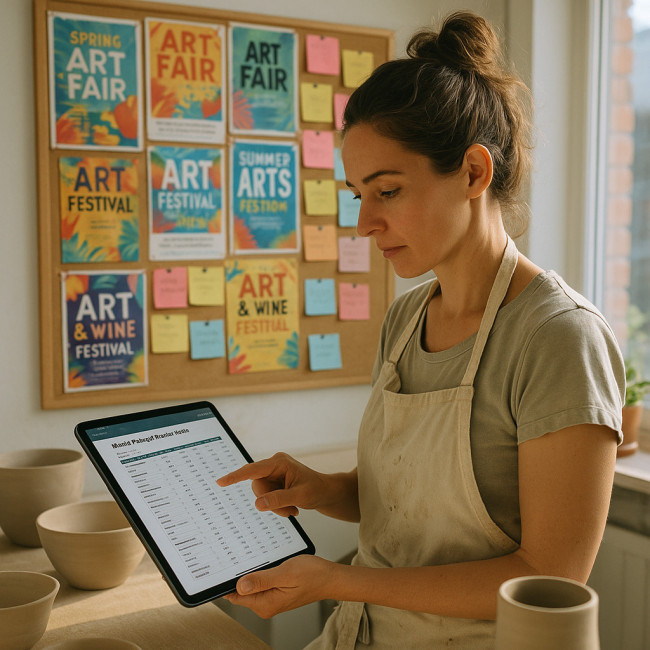Choosing the right art festival: weigh fees, audience size, and sales potential
The art-festival circuit can either supercharge your annual income or drain your cash flow. This guide helps you compare application fees, booth costs, audience numbers, and realistic sales projections so you can choose shows that match your goals—not just your dreams.
Why festival choice shapes your annual revenue
Every event you attend absorbs time, materials, accommodation, and energy. Selecting the wrong one means coming home with unsold stock and an empty wallet. Selecting the right one can finance a new kiln, studio upgrade, or marketing campaign. Because the stakes are high, professional creators treat festival selection as seriously as product design or pricing strategy.
Clarify your objectives before you apply
Set a break-even target
List every direct cost: application fee, booth fee, insurance, travel, lodging, meals, packaging, and credit-card processing. Divide the total by your average price per artwork to reveal the minimum units you must sell. If that number feels unreachable given the audience size, walk away.
Prioritise exposure versus profit
Some festivals attract galleries, licensing scouts, and brand-side artvertisers hunting for fresh talent. In those cases, you might accept a lower immediate profit because long-term commissions offset the hit. Decide where you sit on the exposure-to-profit spectrum before you pay any fee.
Choosing the right art festival: key factors checklist
The four variables below determine whether a show delivers profit, visibility, or heartbreak.
| Factor | What to check | Red flag |
|---|---|---|
| Booth fee | Square-metre price, corner surcharge, electricity, security | No refund policy even if organisers cancel |
| Audience size | Ticket sales history, foot-traffic heatmaps, demographic fit | Inflated “expected visitors” with no past data |
| Sales potential | Average artist revenue, price points that move, payment facilities | Cash-only shows in high-value categories |
| Marketing support | Press outreach, social ads, influencer partnerships | Artists told to “bring your own crowd” |
Analyse fees against projected revenue

Booth charges vary wildly—from €150 at a neighbourhood fair to €2 500+ at high-profile juried events. A low fee is not automatically a win: small local shows can still cost you money if attendees lack the budget for fine art. Conversely, paying a premium can pay off if the crowd is primed to spend and organisers handle aggressive promotion.
Use cost-to-sales ratio
A cost-to-sales ratio below 0.25 is considered healthy by seasoned vendors: for every €1 spent, you earn €4. Track this metric across events to build a data-driven application plan.
Understand audience quality—not just quantity

An audience of 5 000 collectors beats 50 000 casual browsers. Ask organisers for past buyer demographics, average spend per visitor, and return-visitor percentages. Scan social media hashtags from previous editions to gauge the vibe. A queue of buyers carrying protective art tubes and bubble-wrap indicates higher conversion potential than selfie-seekers with iced lattes.
Leverage peer benchmarks
Chat with fellow artists who attended last year. Their candid figures often differ from promotional brochures. You can also read the valuable insights in our article on planning an annual art-event roadmap to align festival timing with production schedules.
Case study: reading the numbers
Below is a snapshot from the 2022 ZAPP® Artist Survey comparing average booth fees and median sales per artist across U.S. festivals.
Source : ZAPP® Artist Survey 2022
The graphic highlights two insights: booth fees rise modestly across tiers, yet median sales scale dramatically. Paying double the fee for a top-tier show can quadruple your sales.
Audit organiser marketing muscle
Investigate the festival's press coverage, email list size, and ad spend. Our deep dive on media outreach before a vernissage shows tactics you can mirror—and indicators that organisers know what they're doing.
Hidden costs that erode profit
- Rain insurance: outdoor shows cancel more often than you think.
- Power access: electricity add-ons reach €100 + at some events.
- On-site parking: daily fees for tall vehicles quickly add up.
- Card-payment hardware: international data plans or rental fees.
Networking and after-sales opportunity
Festivals are not only point-of-sale venues. They double as networking hubs. Techniques from our guide on turning quick chats into lasting partnerships help you monetise leads long after the tent comes down.
Red flags: when to decline an invitation
- A five-figure attendance claim with no ticketing partner to verify numbers.
- “Exposure” promised instead of marketing metrics.
- Payment schedule demanding full booth fee before jury results.
- No clear refund or rollover policy for pandemic or severe-weather cancellations.
Post-festival metrics to track
Keep a spreadsheet with:
- Gross sales
- Number of transactions
- Average sale value
- Newsletter sign-ups
- Commission leads generated
- Cost-to-sales ratio
This data guides next season's applications and supports tiered pricing decisions.
Festival-ready inventory planning
Match inventory to buying patterns. Entry-level prints under €100 sell fastest at small local events. Original works above €1 000 move better at juried shows where collectors attend preview nights.
Quiz: test your festival-selection IQ
FAQ
- How many festivals should I aim for each year?
- Most full-time artists target three to five high-quality shows rather than ten mediocre ones. Fewer events free up studio time and lower travel fatigue.
- Is it worth paying for a corner booth?
- Corner spots increase visibility and traffic flow. If the upgrade costs less than 10 % of your projected sales, veteran vendors recommend it.
- What insurance do I need?
- Public liability (for visitor injuries) and artwork insurance (for theft or damage). Some organisers require proof before hand-over of booth keys.
- How soon should I apply?
- Top-tier juried festivals close applications six to nine months in advance. Set calendar reminders to avoid late fees or wait-list placements.
- Can I share a booth to cut costs?
- Many events allow it if both artists are juried in. Clarify display space allocation and payment splits in writing beforehand.
Action plan
1) List your hard costs and profit goals. 2) Score festivals against audience fit, organiser marketing, and peer data. 3) Apply early, track metrics, and refine next season. Consistent evaluation is the fastest route to sustainable creative income.
Ready to turn your insights into bookings? Start shortlisting shows now and revisit this checklist before you click “Submit”.











